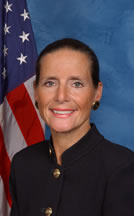|
Washington, D.C. - Over the past couple of weeks, you have probably heard a lot about efforts to renew a federal program called the State Children’s Health Insurance Program, or S-CHIP. This is a very successful and popular program that everyone believes should continue. The debate in Congress is over how best to extend the program.
S-CHIP began as a bipartisan measure passed by a Republican Congress and signed by President Clinton in 1997. At the time, both parties recognized a need for federal program to provide health insurance for children from families who earned too much to qualify for Medicaid but not enough to be able to afford private insurance. The result was a law where the Federal government would provide to states approximately $5 billion annually, roughly 70% of the cost of insuring children who do not qualify for state Medicaid but come from families earning less than 200% of the Federal Poverty Level (FPL), or approximately $40,000 for a family of four.
The program has been a blessing for millions of families. According to the nonpartisan Congressional Budget Office (CBO), S-CHIP’s average monthly enrollment is around 4 million children.
When a federal program is successful, there is often a temptation to expand it, even before the original goals have been met. Under S-CHIP, this expansion has already begun through waivers approved by the Department of Health and Human Services (HHS). According to HHS, 13 states plan to spend more than 44% of their 2008 S-CHIP funds on people who were not originally to receive program benefits. Michigan and New Mexico will spend 71.6% and 52.3%, respectively, of their S-CHIP funds on childless adults. New Jersey is covering children at 350% of poverty (around $70,000 for a family of four) and New York requested a waiver to cover children at 400% of poverty (approximately $82,000 for a family of four).
Even as states have been expanding S-CHIP to cover unintended populations, it is estimated that between 500,000 and 2.5 million children who are eligible for S-CHIP have not yet signed up for the program. Additionally, between 5 and 6 million children who are eligible for S-CHIP or Medicaid have, for some reason, not signed up for either health insurance coverage. The State of Ohio covers approximately 76% of the children eligible for S-CHIP and, according to the Census Bureau, 131,000 children who qualify for either Medicaid or S-CHIP are not insured because they simply haven’t signed up.
S-CHIP is an excellent program. We need to reauthorize it and make certain that no child currently covered by S-CHIP loses that coverage. It is also an ideal time to redouble our efforts to make sure that all children who are eligible for both Medicaid and S-CHIP have health insurance.
Unfortunately, the bill Congress considered, twice, and the President vetoed, did not focus on the neediest children. It sought to increase S-CHIP spending by more than $35 billion over five years and expand coverage to children in families making up to 300% of the poverty level (more than $62,000 for a family of four). According to CBO, the current proposal to expand S-CHIP will result in as little as 33% of the neediest children receiving the coverage they need. The rest will likely be forgotten. Further, CBO estimates, that 1.1 million of the newly S-CHIP-eligible children, those in families making between $41,000 and $62,000, will obtain insurance through the federal government. Of those 1.1 million, almost half will leave private insurance plans for government-funded health plans.
This plan makes no sense and does very little for those truly in need in Ohio and around the country. S-CHIP is an excellent program that was meant to fill an important health insurance gap. It has helped millions of children, but it has not yet fulfilled its original mission.
Finding a bipartisan compromise to extend and even expand S-CHIP could be simple. Unfortunately, Democratic leaders would rather play politics than come together with a real solution that truly helps the neediest among us.
###
Return to News Center
|
|


